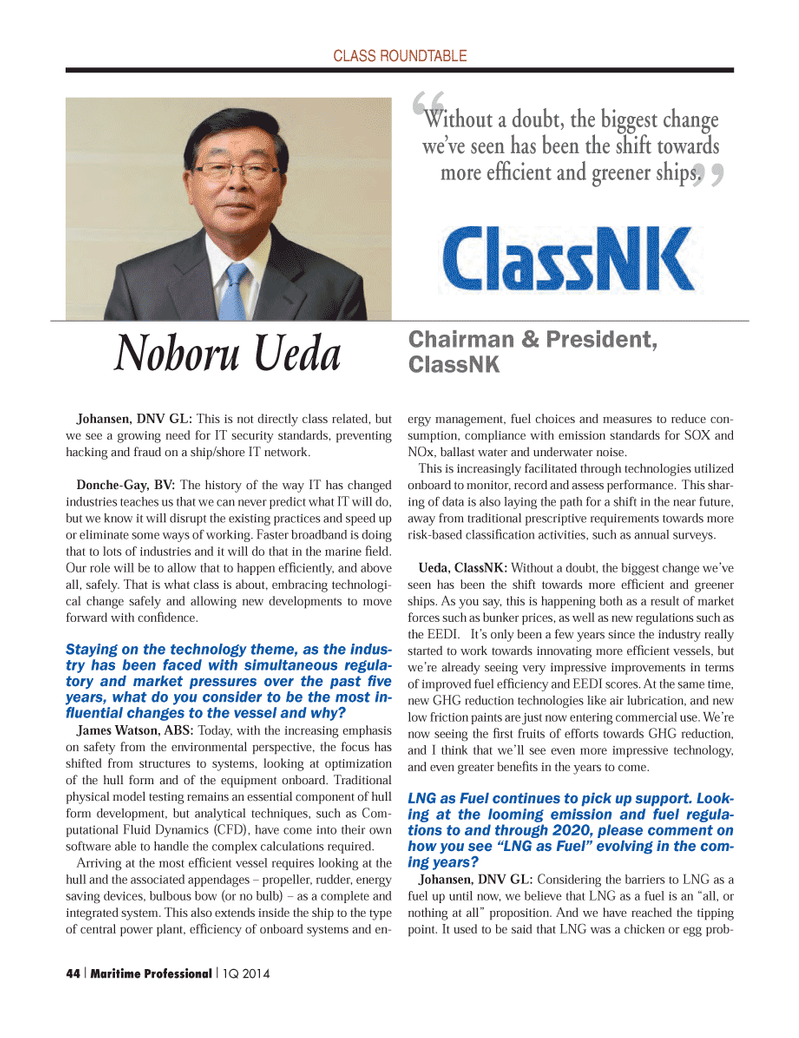
Page 44: of Maritime Logistics Professional Magazine (Q1 2014)
The Energy Edition: Exploration, Production & Transportation
Read this page in Pdf, Flash or Html5 edition of Q1 2014 Maritime Logistics Professional Magazine
CLASS ROUNDTABLE
Johansen, DNV GL: This is not directly class related, but we see a growing need for IT security standards, preventing hacking and fraud on a ship/shore IT network.
Donche-Gay, BV: The history of the way IT has changed industries teaches us that we can never predict what IT will do, but we know it will disrupt the existing practices and speed up or eliminate some ways of working. Faster broadband is doing that to lots of industries and it will do that in the marine fi eld.
Our role will be to allow that to happen effi ciently, and above all, safely. That is what class is about, embracing technologi- cal change safely and allowing new developments to move forward with confi dence.
Staying on the technology theme, as the indus- try has been faced with simultaneous regula- tory and market pressures over the past fi ve years, what do you consider to be the most in- fl uential changes to the vessel and why?
James Watson, ABS: Today, with the increasing emphasis on safety from the environmental perspective, the focus has shifted from structures to systems, looking at optimization of the hull form and of the equipment onboard. Traditional physical model testing remains an essential component of hull form development, but analytical techniques, such as Com- putational Fluid Dynamics (CFD), have come into their own software able to handle the complex calculations required.
Arriving at the most effi cient vessel requires looking at the hull and the associated appendages – propeller, rudder, energy saving devices, bulbous bow (or no bulb) – as a complete and integrated system. This also extends inside the ship to the type of central power plant, effi ciency of onboard systems and en- ergy management, fuel choices and measures to reduce con- sumption, compliance with emission standards for SOX and
NOx, ballast water and underwater noise.
This is increasingly facilitated through technologies utilized onboard to monitor, record and assess performance. This shar- ing of data is also laying the path for a shift in the near future, away from traditional prescriptive requirements towards more risk-based classifi cation activities, such as annual surveys.
Ueda, ClassNK: Without a doubt, the biggest change we’ve seen has been the shift towards more effi cient and greener ships. As you say, this is happening both as a result of market forces such as bunker prices, as well as new regulations such as the EEDI. It’s only been a few years since the industry really started to work towards innovating more effi cient vessels, but we’re already seeing very impressive improvements in terms of improved fuel effi ciency and EEDI scores. At the same time, new GHG reduction technologies like air lubrication, and new low friction paints are just now entering commercial use. We’re now seeing the fi rst fruits of efforts towards GHG reduction, and I think that we’ll see even more impressive technology, and even greater benefi ts in the years to come.
LNG as Fuel continues to pick up support. Look- ing at the looming emission and fuel regula- tions to and through 2020, please comment on how you see “LNG as Fuel” evolving in the com- ing years?
Johansen, DNV GL: Considering the barriers to LNG as a fuel up until now, we believe that LNG as a fuel is an “all, or nothing at all” proposition. And we have reached the tipping point. It used to be said that LNG was a chicken or egg prob-
Chairman & President,
ClassNK “ ”
Without a doubt, the biggest change we’ve seen has been the shift towards more effi cient and greener ships.
Noboru Ueda 44 I Maritime Professional I 1Q 2014
MP Q1 2014 34-49.indd 44 2/26/2014 1:31:01 PM

 43
43

 45
45
